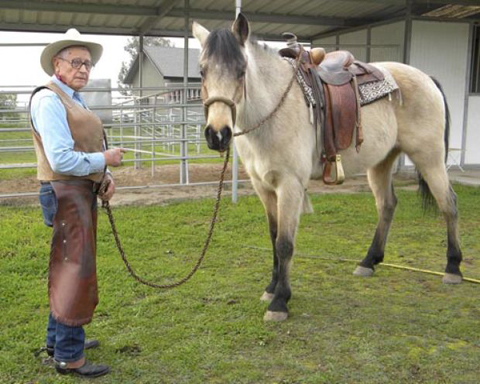
From the Santa Inez Valley News
In an unpretentious, rural part of Madera, lives one of the last unassuming true Vaqueros — Ray Ordway, sometimes referred to as the “Dean of Vaqueros.”
It is fitting that the 89-year-old Ordway has been selected as this year’s “Honored Vaquero” at the Santa Ynez Valley Historical Museum’s annual Vaquero Show & Sale, Nov. 8-10. Ordway will be honored at the Gala Vaquero Dinner on Friday, Nov. 8, at Old Mission Santa Inés.
Although Ordway’s vaquero days were in the San Joaquin Valley, he holds deep feelings for Santa Barbara County where his father’s vaquero days began in the 1890s, and where Ordway family members reside today.
Having worked in the cattle business his entire life, Ordway remains dedicated to preserving and sharing the Vaquero horsemanship traditions that are so unique to Central California.
“I’m glad to lend my help and to support the vaquero traditions wherever I can; it’s so important to keep the traditions alive and pass them along to younger generations, learning a sense of respect for the horse, livestock and for people — it’s all part of the true vaquero culture,” said Ordway.
In his early life Ordway followed the California vaquero traditions of his father Ira, uncles and older brothers working long, hard days on open ranch land, handling cattle, branding, colt starting and absorbing knowledge from old-time masters of the California Spanish style.
Ordway’s family migrated to California in 1870. Ira, his father, was born in 1879, and by age 14 had joined his two older brothers working on the historic Rancho Jesus Maria in Santa Barbara County drawing $5 a month pay. This 1837 Mexican land grant rancho of 42,185 acres along the Pacific coastline from Shuman Canyon south to the Santa Ynez River encompassed today’s Vandenberg Air Force Base.
Also working with the Ordways at the Rancho Jesus Maria was future western artist Edward Borein who captured much of the “vaquero era” first-hand, sketching on scraps of paper and the walls of his bunkhouse. Borein is well-remembered in Santa Barbara today as one of California’s most noted artists.
Ordway recalls his father fondly speaking of the old vaqueros. They rode with spade bits and roped with riatas. Their horses maneuvered at the lightest touch.
Early Spanish vaqueros were often hesitant to share knowledge and skills with young “buckaroos,” so Ira learned to read and write Castilian Spanish to better communicate with these masterful horsemen. His ability to communicate in their native language proved beneficial. Thus began the legacy that Ira passed on to his four sons, all of whom became outstanding bridle horsemen in the old California style.
In 1906 Ira married and established himself in Mendocino County with brother Ed running cattle on 88,000 acres using the Lazy Hook Diamond brand which now has been in the Ordway family for more than 100 years, currently registered to Ray.
Ordway remembers riding in the saddle in front of his father as he moved cattle, and by age 13 he and his brother Jack started a cattle business called “Ordway Brothers”.
After graduating high school, Ray and Jack worked for older brother Kent on the Oak Flat Ranch working 20,000 acres. Ray was drafted into the Army Air Corps and returned in 1946. With good vaquero skills, he hired out for day work at $8 a day — starting colts and working cattle in the San Joaquin Valley.
By the 1950s Ordway saw ranching styles change along with land use, cattle management and horse breeds. The quarter horse entered the scene, but didn’t fit the “vaquero style.” The old Spanish and Morgan breed with its head held higher, alert, enduring and “ready to work” was preferred by the Ordways; and Ray preferred working on ranches who stayed more traditional in styles.
In 1954, Ordway’s father Ira and brother Kent passed away. Ray relocated to Merced and ran Ira’s ranch, and later managed his brother Kent’s Vasco Ranch.
Ordway married LaVerne Disbro in 1957. They have been married for 56 years. Again he saw time change for the traditional vaquero and cattle ranching. “Old vaquero” styles were fading, replaced with a “cowboy and rodeo” style. However, Ordway continued in the cattle business, starting colts in the California bridle horse tradition, for his own use, while hiring out for day work. In the 1960s, ironically he worked on 5,000 acres of the old San Luis Gonzaga Ranch — the same land his father rode in 1898.
In recent years Ordway has participated in brandings proudly riding his Morgan gelding and using a traditional riata. In 2012, he retired from the saddle. Ordway said he is pleased to see the resurgence of interest in California’s vaquero style of horsemanship
